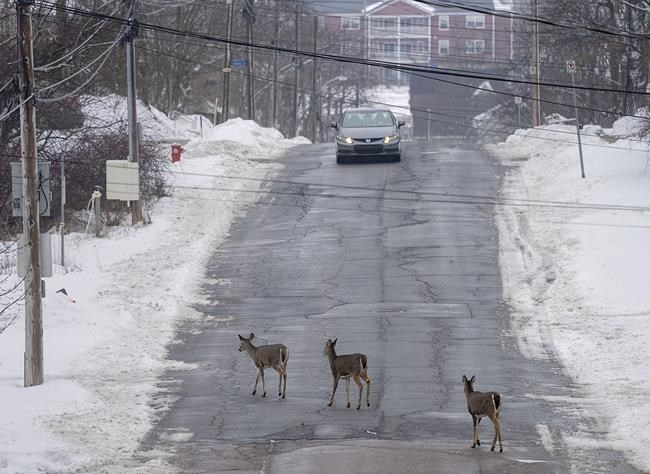HALIFAX — Fed up with nuisance deer raiding gardens and colliding with vehicles, a town in central Nova Scotia has hired four crossbow hunters to kill up to 20 of the animals inside town limits.
"There been a lot of property damage, and it's not just gardens," said Mike Dolter, Truro's chief administrative officer. "Trees are getting eaten, and they're adapting to plants thought to be deer-resistant .... We've had aggressive deer, particularly in rutting season with bucks in yards, and people have been afraid to go outside."
But a British Columbia-based group dealing with the same problem and a prominent Nova Scotia biologist both say the upcoming municipal hunt, believed to be the first of its kind in Canada, won't solve anything.
Bob Bancroft, president of Nature Nova Scotia, says Truro's white-tailed deer will continue to be a bother as long as local residents keep feeding them.
"When you end up with 30 animals in one backyard and people are throwing carrots out the window, it's ridiculous," said Bancroft, who worked for 15 years as a wildlife biologist with the provincial government.
Bancroft said the looming cull — the town prefers to call it a hunt — will be only a temporary solution, because the surviving deer will soon be joined by others that will move into town to take advantage of the easy meals provided by residents.
"It's happening all over North America," Bancroft said in a recent interview, referring to the fact that 300 years of industrial forestry has displaced large populations of deer from their natural habitat. "When you degrade the forest and the soils, you wind up with regeneration that is very poor in nutrition for the deer. They end up moving into private lands that are ecologically more healthy."
Bancroft said the community of 12,000 would be better off trying to adapt to the deer, rather than killing them.
Dolter, Truro's chief administrative officer since 2017, said municipal officials have studied the problem for years, and they've mounted public education campaigns to stop residents from handing out backyard goodies. But the campaigns haven't worked, and the deer keep coming.
The decision to employ crossbow hunters was based partly on the fact that long guns can't be used inside the town's boundaries. Dolter says the designated hunting locations — each baited with apples — are at least 800 metres from any schools or built-up areas and have been set up so crossbow projectiles, known as bolts, will end up in the ground or nearby hay bales if they miss their target.
"We have no illusions that we're going to take 20 deer and suddenly see a big drop in the population," he said. "This will take a number of years to achieve."
Dolter said the crossbow plan has angered some local residents. "Some people are not in favour of this and think it's cruel," he said. "But the evidence we have is that it is not." He added that the town dismissed the idea of trapping and relocating the animals because they often suffer and go into shock.
In Longueuil, Que., a plan to capture and kill most of the deer living in a local park was initially shelved after a strong public backlash that included a petition, a protest and threats against the former mayor. Michel-Chartrand Park is home to about 70 deer — more than five times the number of animals it can comfortably support.
The suburb south of Montreal considered other options, including relocating the deer or reducing their numbers with birth control, but it concluded the only viable option was to capture and euthanize all but 10 to 15 animals, and it has said it will proceed with the cull this year.
In recent years, the town of St. Andrews in southwestern New Brunswick — at one point home to 13 deer per square kilometre — has approved an annual nuisance deer hunt, but it takes place on private land during the regular hunting season.
In Oak Bay, B.C., a community of 18,000 east of Victoria, an innovative birth control program is showing promising results.
The project, led by the Urban Wildlife Stewardship Society, followed public outage sparked by a cull in 2015 that saw 11 black-tailed deer trapped in a net-like device and killed with a bolt gun — the same device used to slaughter cattle.
"It was pretty brutal," said Kristy Kilpatrick, president of the three-year-old volunteer organization that includes community members, scientists and wildlife experts. "They came together, determined there had to be a better way and it needed to be rooted in science."
Using an array of about three dozen motion-activated cameras, the group determined the area was home to about 100 deer or more. In 2019 and 2020, 120 does were tranquilized with a dart gun and injected with an immunocontraceptive.
"At this point in our research, it's looking incredibly positive," Kilpatrick said in a recent interview. "The data so far tell us that the birthrate has been reduced by 60 per cent." She said there have been few complaints from residents, other than a few comments about the lack of fawns in the area.
Like Bancroft, Kilpatrick said culls don't work.
"When you remove a large number of deer from any given area, what happens in a fairly short period of time is that more deer move in and the birthrate goes up," she said. "You're actually exacerbating the problem unless you do it year after year."
This report by The Canadian Press was first published Jan. 16, 2022.
Michael MacDonald, The Canadian Press




